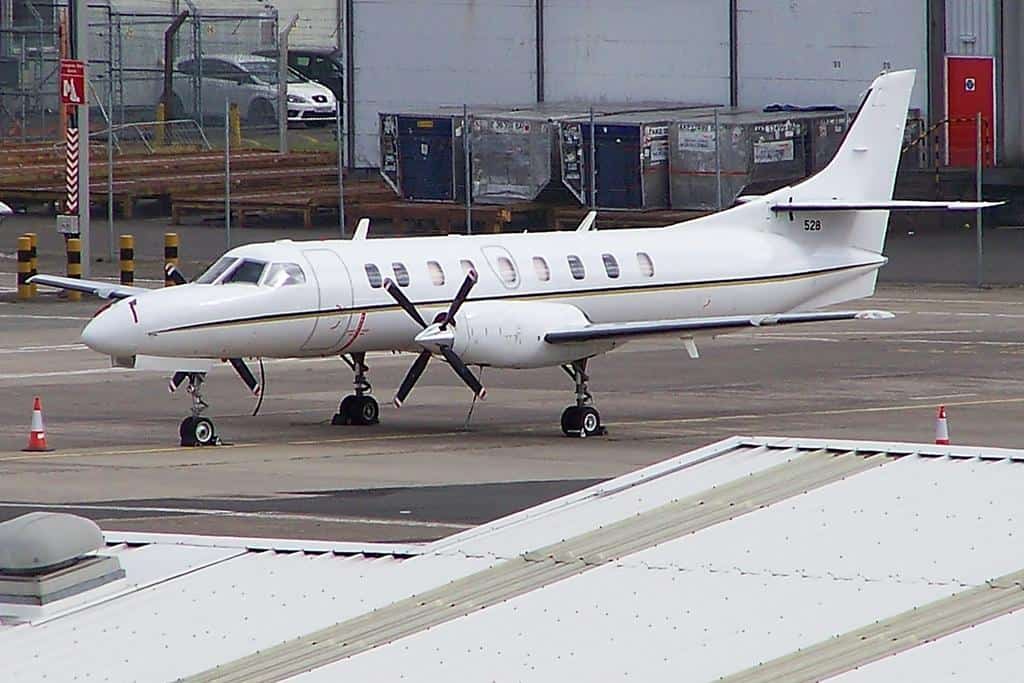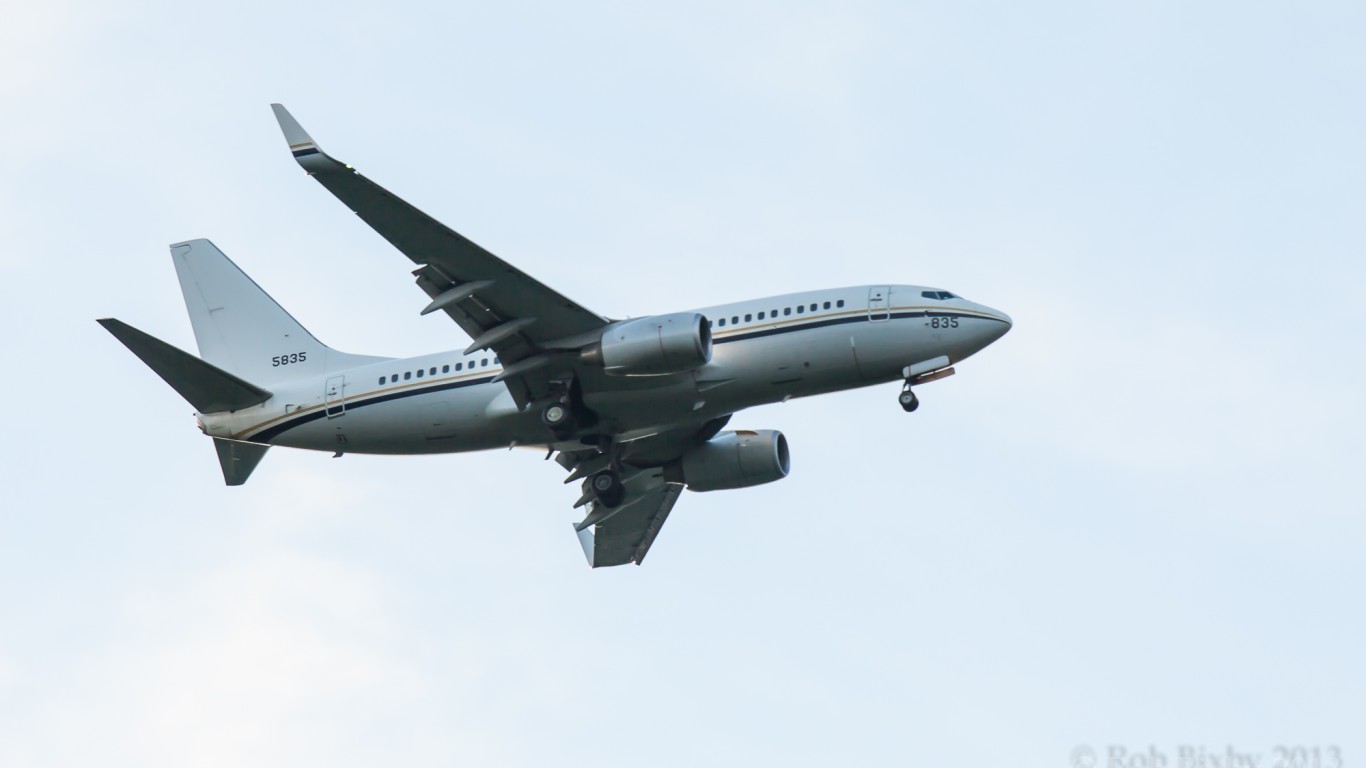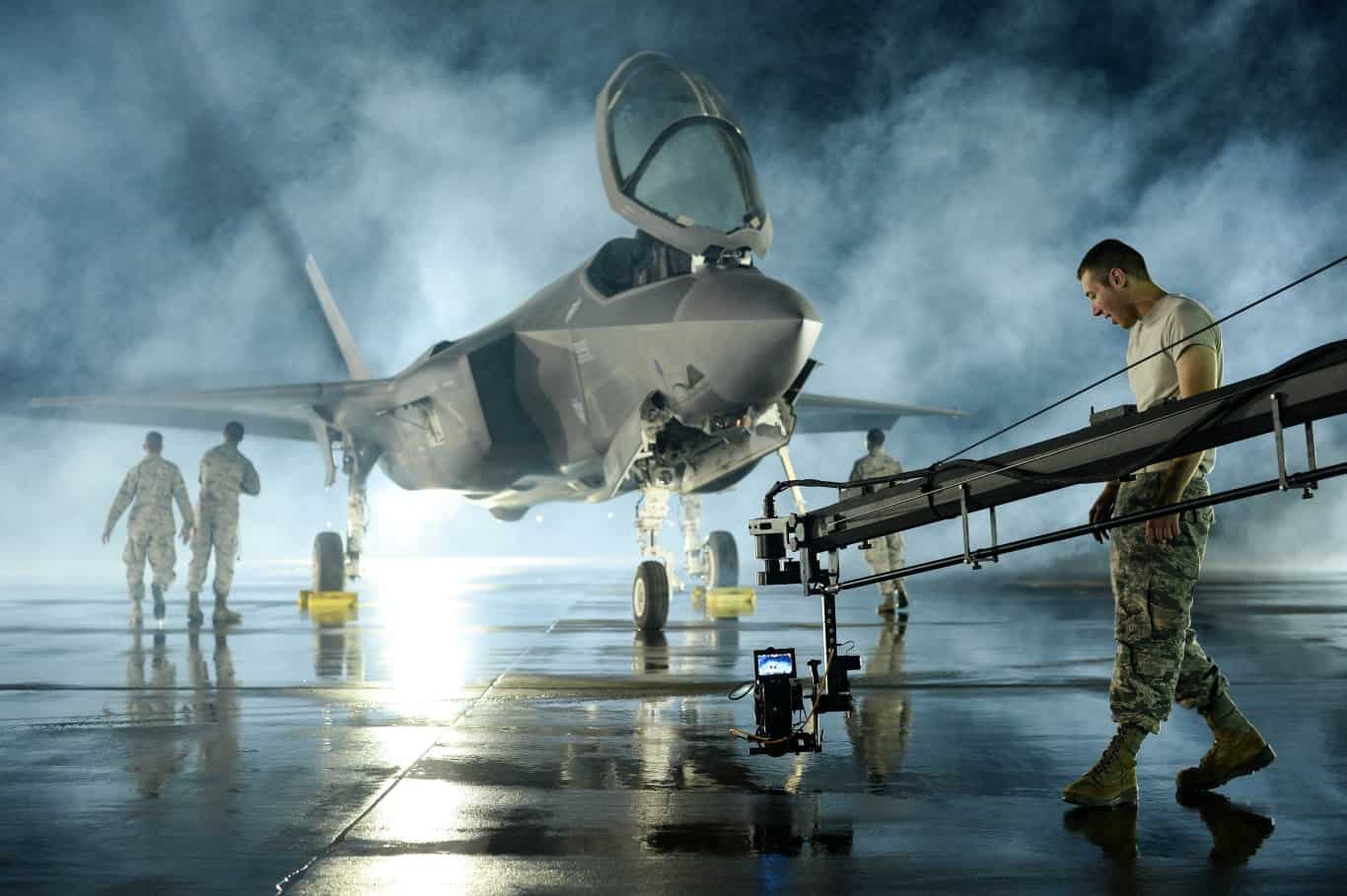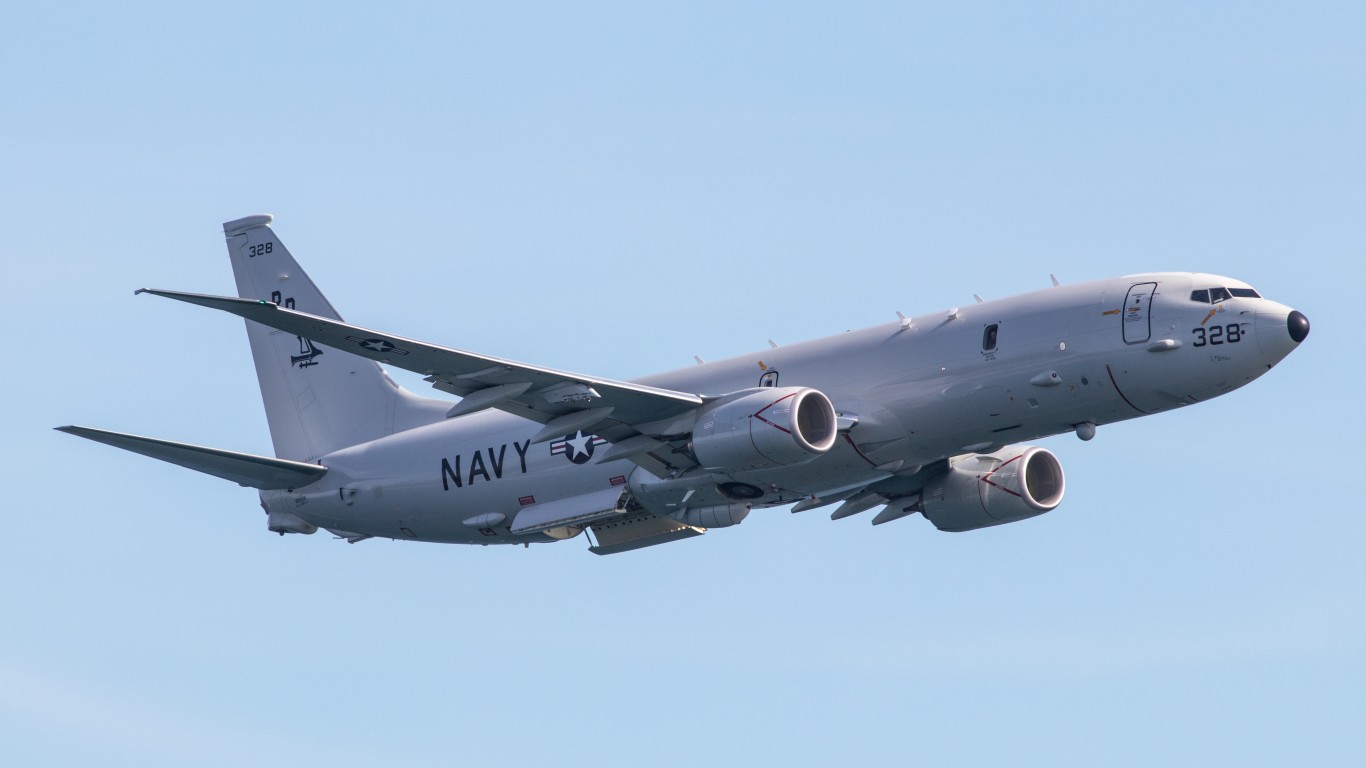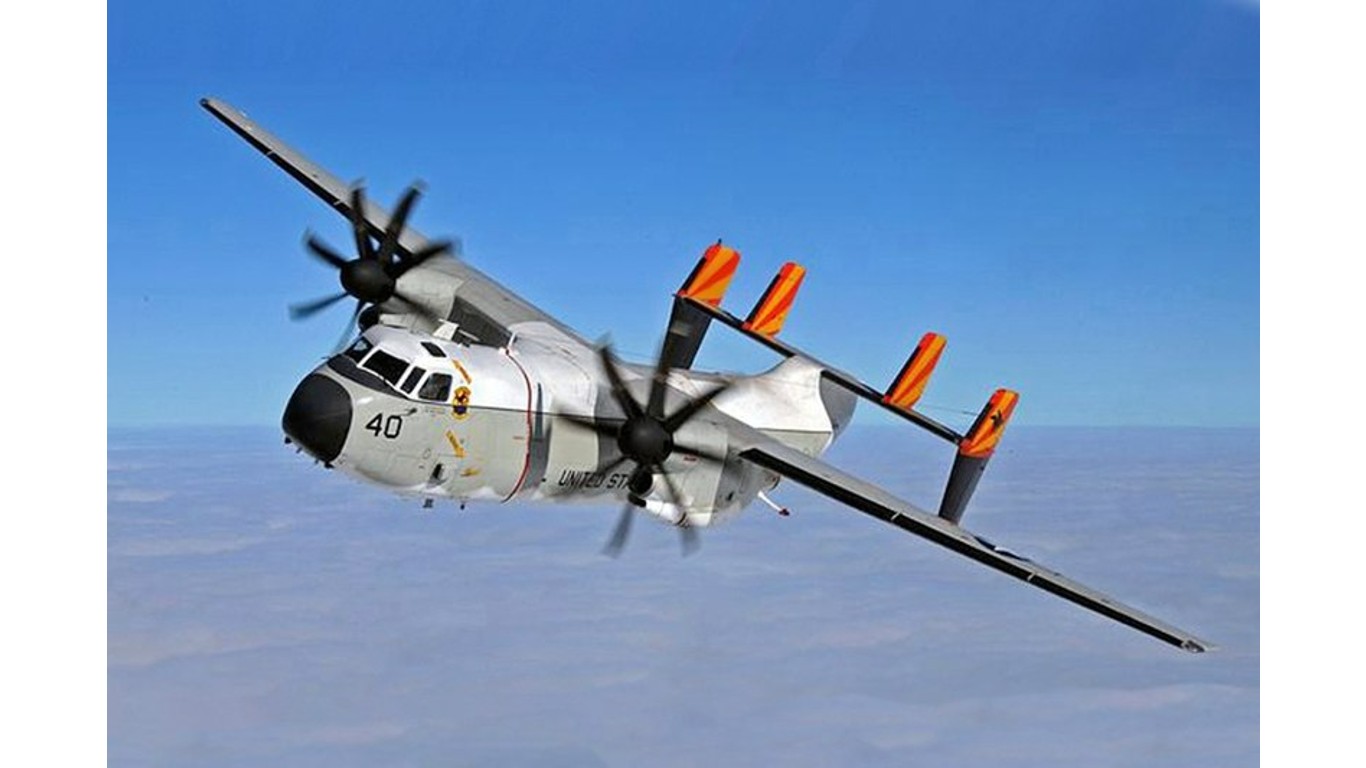
24/7 Wall St. Insights:
- The U.S. Navy boasts a wide array of combat and logistical aircraft
- The F/A-18 Super Hornet is one of the most iconic Navy aircraft, it was introduced in the late 1990s
- The Super Hornet comes standard with a 20mm M61A2 Vulcan cannon. It can further be outfitted with an array of missiles and joint direct attack munitions, including Sidewinders, Harpoons, Mavericks, and AMRAAMs
- Also: Discover the next Nvidia
By far and away, the U.S. Navy is the strongest maritime force on the planet. The Navy owes much of this to its impressive fleet of destroyers, submarines, and aircraft carriers. However as a standalone force, its air power is one of the strongest in the world as well. Boasting some of the most advanced fighter aircraft in the world that can be deployed from aircraft carriers or land bases, the Navy has a vast array of aircraft at its disposal. (These are the newest aircraft carriers in U.S. Navy history.)
24/7 Wall St. is taking a closer look at the Navy’s arsenal of aircraft both combat and logistical. To identify every aircraft flown by the U.S. Navy, 24/7 Wall St. reviewed data from the 2024 World Air Forces report from FlightGlobal, an aviation and aerospace industry website, and ranked the aircraft alphabetically. Additionally, we’ve included supplemental information on the type of aircraft, how many are in active service, top speed and armament. We have excluded all trainer aircraft.
The F/A-18 Super Hornet is perhaps one of the most iconic aircraft currently in service of the Navy today. It has been a mainstay since the late 1990s and it is widely known for its versatility. These jets come standard with twin General Electric F414-GE-400 engines, which deliver a staggering 22,000 pounds of thrust, enabling speeds up to Mach 1.6, or about 1,200 mph.
In terms of its armament, the Super Hornet comes standard with a 20mm M61A2 Vulcan cannon. It can further be outfitted with an array of missiles and joint direct attack munitions, including Sidewinders, Harpoons, Mavericks, and AMRAAMs. (The Super Hornet is one of the most heavily armed Navy aircraft.)
At the same time, the Navy’s fleet has made some new additions with the F-35 Lightning II, specifically the carrier-based C-variant. This fifth-generation fighter jet pushes the envelope with advanced stealth capabilities and advanced avionics.
However, these jets do not come cheap, the cost for the F-35 ranges depending on the variant and is fairly high compared to other fighter jets. The F-35A is the stock standard variant and costs roughly $110 million per unit. The B variant costs slightly more at around $136 million per unit but it incorporates a short take-off and vertical landing system, which allows it to take off from extremely short runways as well land vertically. The C variant is designed to be launched from aircraft carriers and costs about $117 million per unit.
What makes the F-35 Lightning II special is that it brings next-level features like stealth, maneuverability, and the ability to cruise at supersonic speeds without afterburners. Also, it’s versatile with its weapons load, and capable of carrying up to 18,000 pounds of munitions.
Like the Super Hornet, the F-35 is armed with a 25mm GAU-22/A cannon and can be equipped with various missiles and munitions, showcasing its readiness to dominate modern combat scenarios.
The Super Hornet and F-35 Lightning II are just two aircraft in service of the U.S. Navy. There’s a number of other combat and logistical aircraft that fill out its fleet.
Here is a look at every aircraft in the U.S. Navy:
Why Are We Covering This?
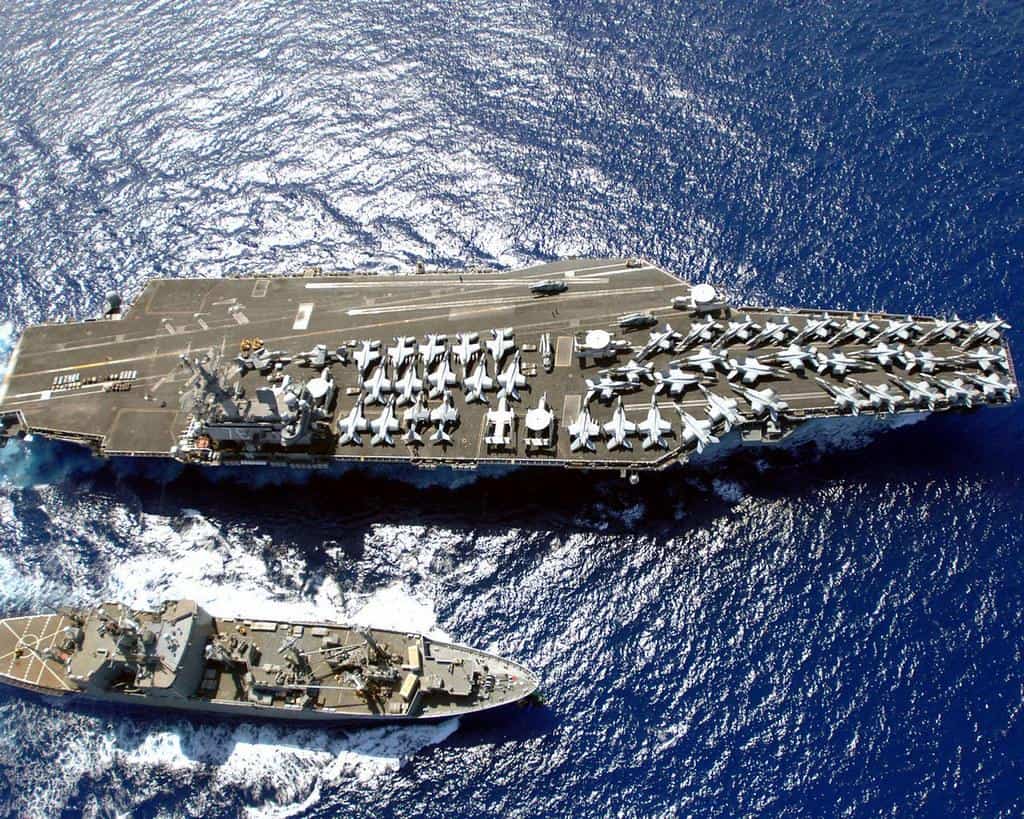
24/7 would like our readers to understand where their tax dollars are being spent. The Navy received $202.6 billion in government funding in 2024, second only to the Air Force at $216.1. billion. In fiscal year 2025, the Navy has requested $16.6 billion of its funding to purchase 75 aircraft and helicopters, which is actually slightly less than in 2024.
Bell 407
- Type: Light utility helicopter
- Year introduced: 1996
- Active aircraft: 5
- Top speed: 162 mph
- Armament: N/A
The Bell 407 is a light utility helicopter that was introduced in 1996. It can hit a top speed of 162 mph. These are typically used for a variety of missions, including transport, emergency medical services, and search and rescue operations.
C-12 Huron
- Type: Special mission aircraft
- Year introduced: 1974
- Active aircraft: 13
- Top speed: 332 mph
- Armament: N/A
Typically, the C-12 Huron is used for transporting personnel, cargo, and medical evacuation missions.
C-130J Super Hercules
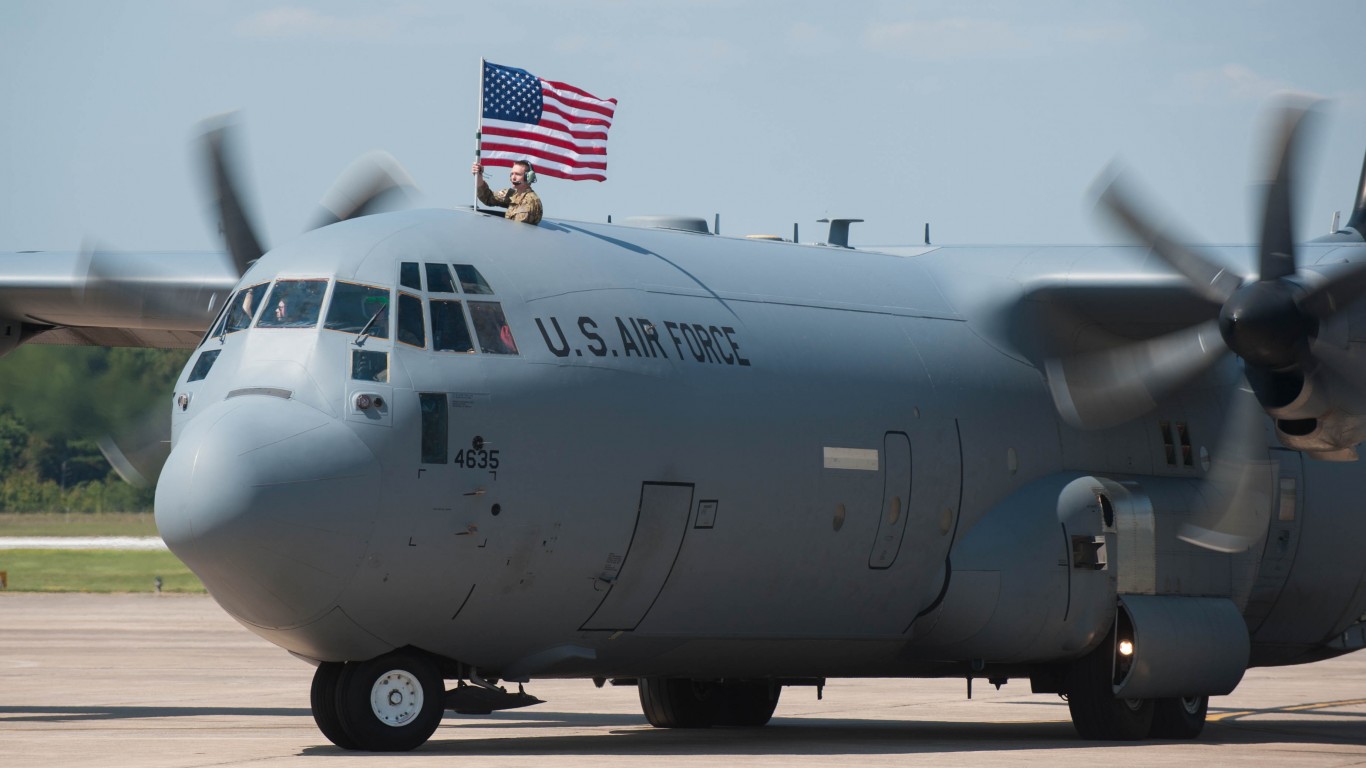
- Type: Tactical medium transport aircraft
- Year introduced: 1999
- Active aircraft: 18
- Top speed: 416 mph
- Armament: N/A
The C-130J Super Hercules is known as the workhorse of the U.S. military with over 300 currently in service of the U.S. Air Force alone. These massive aircraft act as the logistical backbone of the fleet.
C-2 Greyhound

- Type: Carrier-based cargo / transport aircraft
- Year introduced: 1967
- Active aircraft: 26
- Top speed: 331 mph
- Armament: N/A
Introduced in 1967, the C-2 Greyhound serves as a carrier-based cargo and transport aircraft with a total of 26 units currently in the Navy. This aircraft is capable of reaching a top speed of 331 mph and carries no armament. It plays an important role in transporting cargo, mail, and personnel to and from aircraft carriers.
C-20 Gulfstream IV

- Type: Military VIP passenger transport aircraft
- Year introduced: 1983
- Active aircraft: 2
- Top speed: 582 mph
- Armament: N/A
Normally, the C-20 Gulfstream IV is used for high-level government officials and military leaders as a VIP transport.
C-26D Metroliner
- Type: Transport aircraft
- Year introduced: 2003
- Active aircraft: 8
- Top speed: 331 mph
- Armament: N/A
Currently, there are 8 active C-26D Metroliners in service of the U.S. Navy. The C-26D was introduced as a transport aircraft in 2003, and it can hit a top speed of 331 mph. This aircraft is often used by the Navy for light transport and communication, particularly in areas that require a quick turnaround and access to smaller airfields.
C-40 Clipper
- Type: Transport aircraft
- Year introduced: 2001
- Active aircraft: 17
- Top speed: 544 mph
- Armament: N/A
Introduced in 2001, the C-40 Clipper is a transport aircraft with a top speed of 544 mph. It’s worth noting that the C-40 is a military variant of the Boeing 737-700C.
E-2 Hawkeye
- Type: Airborne command post
- Year introduced: 1964
- Active aircraft: 83
- Top speed: 375 mph
- Armament: N/A
The E-2 Hawkeye was first introduced in 1964 and serves as an airborne command post, with 83 units currently active. This aircraft can hit a top speed of 375 mph. Although it carries no armament, the Hawkeye is instrumental in providing all-weather airborne early warning as well as command and control functions.
E-6B Mercury
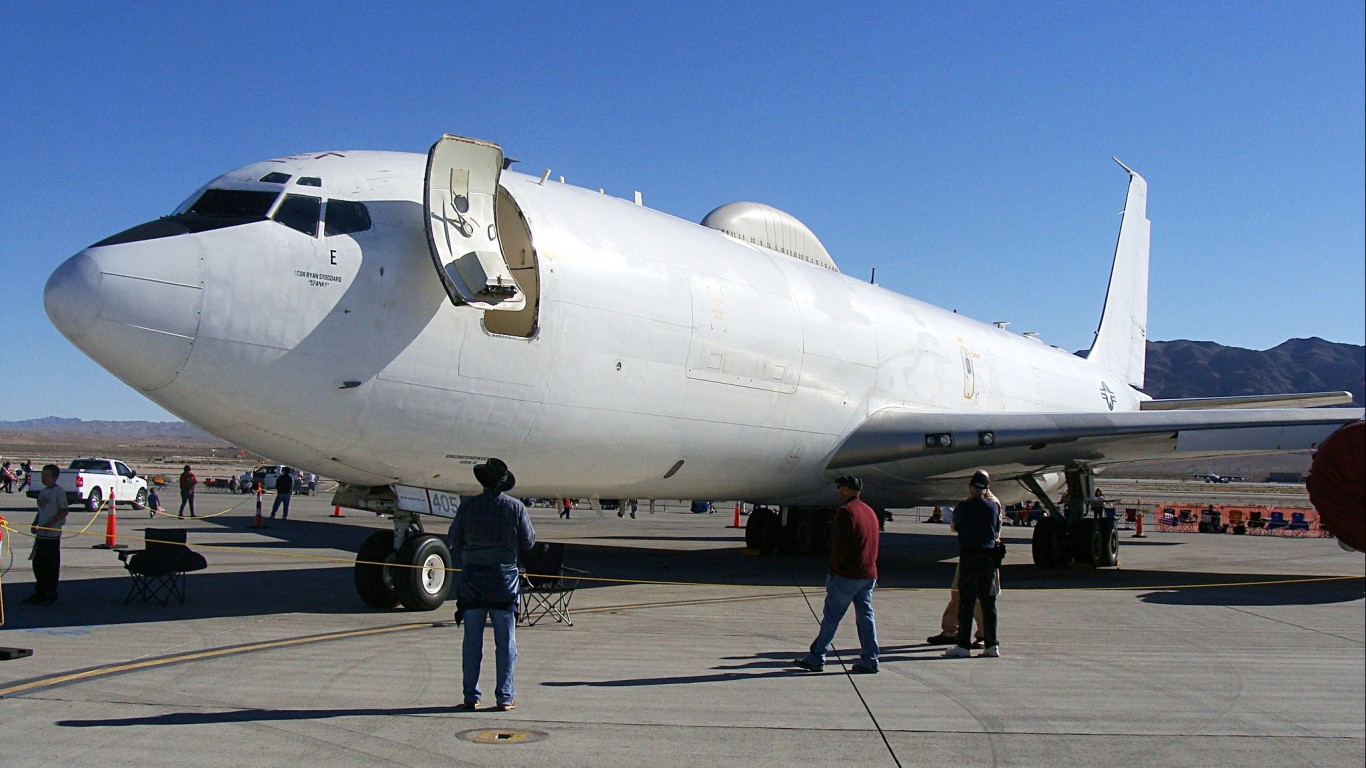
- Type: Airborne command post
- Year introduced: 1989
- Active aircraft: 16
- Top speed: 603 mph
- Armament: N/A
This high-speed aircraft facilitates advanced command, control, and communications functions to link the national command authority with U.S. nuclear forces. The E-6B Mercury was introduced in 1989 and can hit speeds over 603 mph. There are 16 active units in the U.S. Navy.
EA-18G Growler
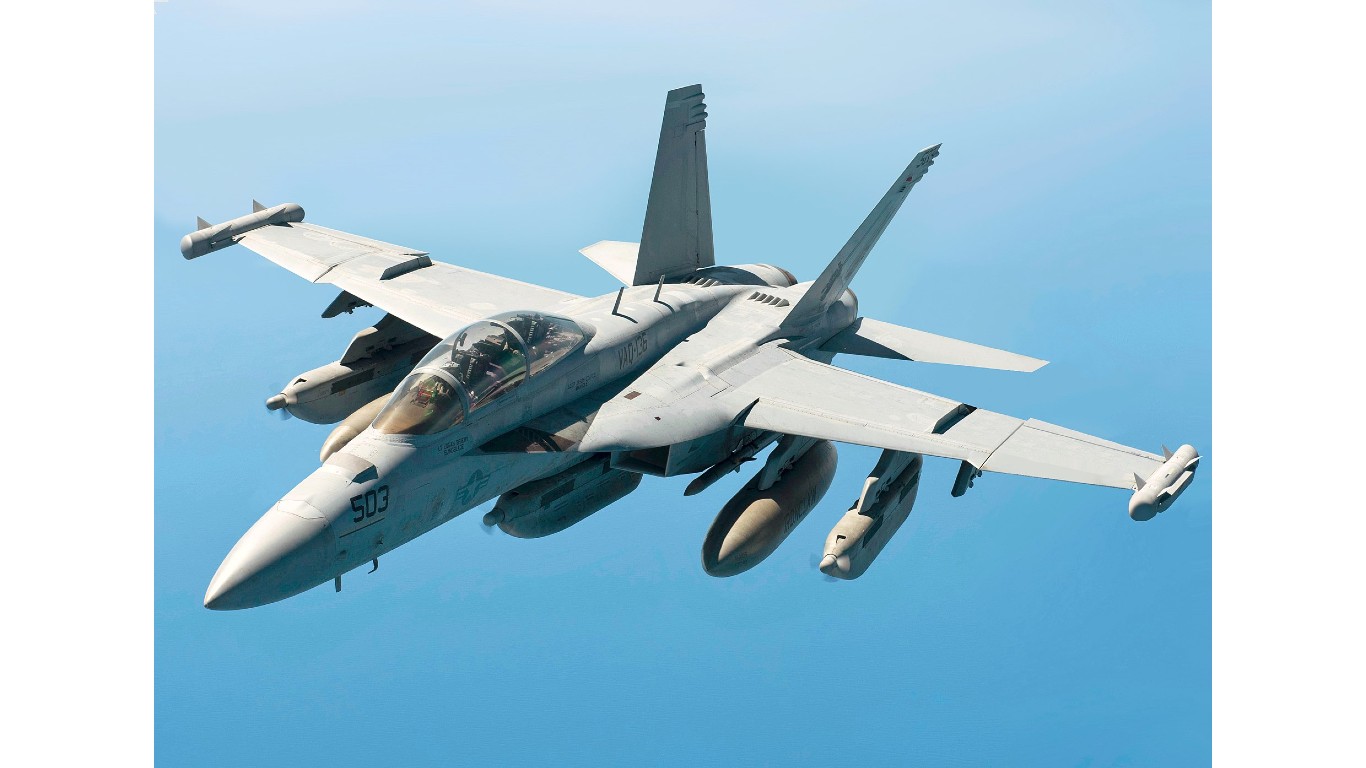
- Type: Carrier-based electronic warfare aircraft
- Year introduced: 2009
- Active aircraft: 153
- Top speed: 1,181 mph
- Armament: Detection pods, high band jamming pods, low band jamming pods, AN/ASQ-228 ATFLIR, SHARP, Harm missiles, AMRAAM missiles, Joint stand-off weapons
The EA-18G Growler is a carrier-based electronic warfare aircraft that was introduced in 2009. Currently there are just over 150 of these aircraft in service. These jets can hit a top speed of 1,181 mph and can equip a wide array of weapons.
The Growler is not only equipped for combat but also for electronic warfare, some of this includes detection and jamming pods to disrupt enemy sensors and communications. It’s worth noting that these jets are a specialized variant of the F/A-18F Super Hornet.
These jets play an important role in protecting strike aircraft by preemptively jamming enemy radar and intercepting communications, clearing the path for less stealthy fighters.
F-35C Lightning II
- Type: Multi-role fifth generation strike fighter aircraft
- Year introduced: 2016
- Active aircraft: 30
- Top speed: 1,199 mph
- Armament: 25mm GAU-12/U cannon in external pod, Sidewinder missiles, Pave way guided bombs, Rockeye II bombs, Brimstone missiles, Storm shadow missiles, drop bombs
The F-35 Lightning II is one of the newest additions to the U.S. Navy. As a fifth-generation strike fighter aircraft, the Lightning II can play a number of roles incorporating the newest stealth technology.
Introduced in 2016, the F-35C Lightning II boasts a top speed of 1,199 mph and can equip a wide variety of weapons. Currently, there are 30 in active service for the U.S. Navy but hundreds more are on order from Lockheed Martin for the U.S. military at large.
F/A-18 Super Hornet
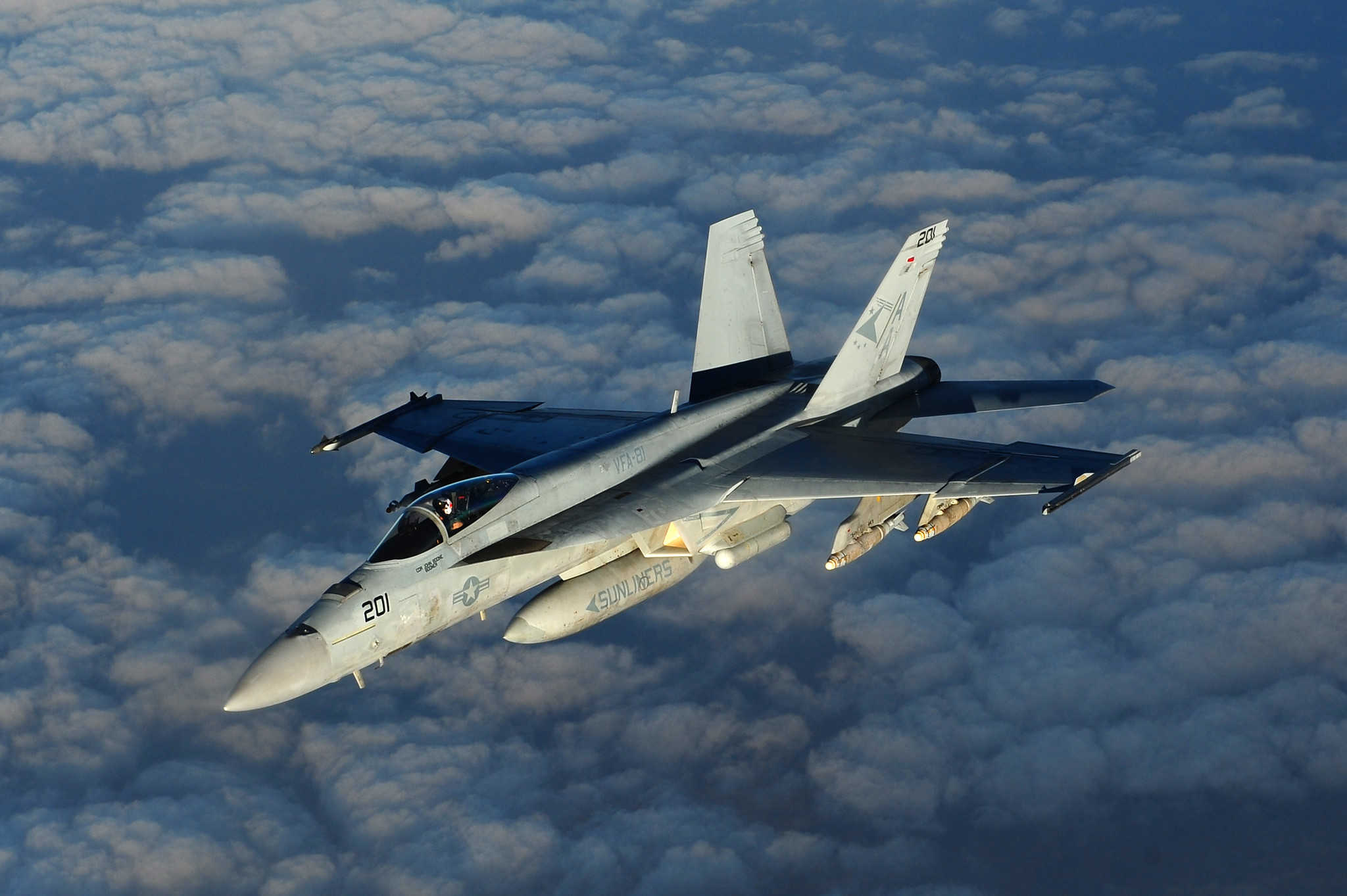
- Type: Carrier-based strike fighter aircraft
- Year introduced: 1999
- Active aircraft: 421
- Top speed: 1,187 mph
- Armament: 20mm M61A1 Vulcan automatic cannon, Sidewinder missiles, AMRAAM missiles, Harpoon missiles, HARM missiles, Maverick missiles, joint direct attack munitions, Rockeye II bombs, general purpose bombs
The F/A-18 Super Hornet was introduced in 1999 as a carrier-based strike fighter aircraft. There are currently over 400 of these aircraft in service of the U.S. Navy.
These jets are capable of reaching speeds up to 1,187 mph and are typically armed with a 20mm M61A1 Vulcan cannon and a variety of missiles and bombs, including Sidewinders, AMRAAMs, Harpoons, HARMs, Mavericks, as well as precision joint direct attack munitions and conventional bombs.
The Super Hornet is designed with a larger airframe, more advanced radar systems, and greater fuel capacity than its predecessor, the original F/A-18 Hornet. These upgrades significantly improve the Super Hornet’s range and endurance.
KC-130 Super Hercules

- Type: Aerial tanker / transport aircraft
- Year introduced: 1962
- Active aircraft: 11
- Top speed: 416 mph
- Armament: N/A
The KC-130 is a variant of the C-130J Super Hercules, specifically modified for aerial refueling, but still capable of its transport duties. The Navy currently maintains a fleet of 11 active units. The KC-130 can hit a top speed of 416 mph and carries no armament. Its dual role allows for more operational flexibility and support for air and ground forces.
MH-53E Pave Low
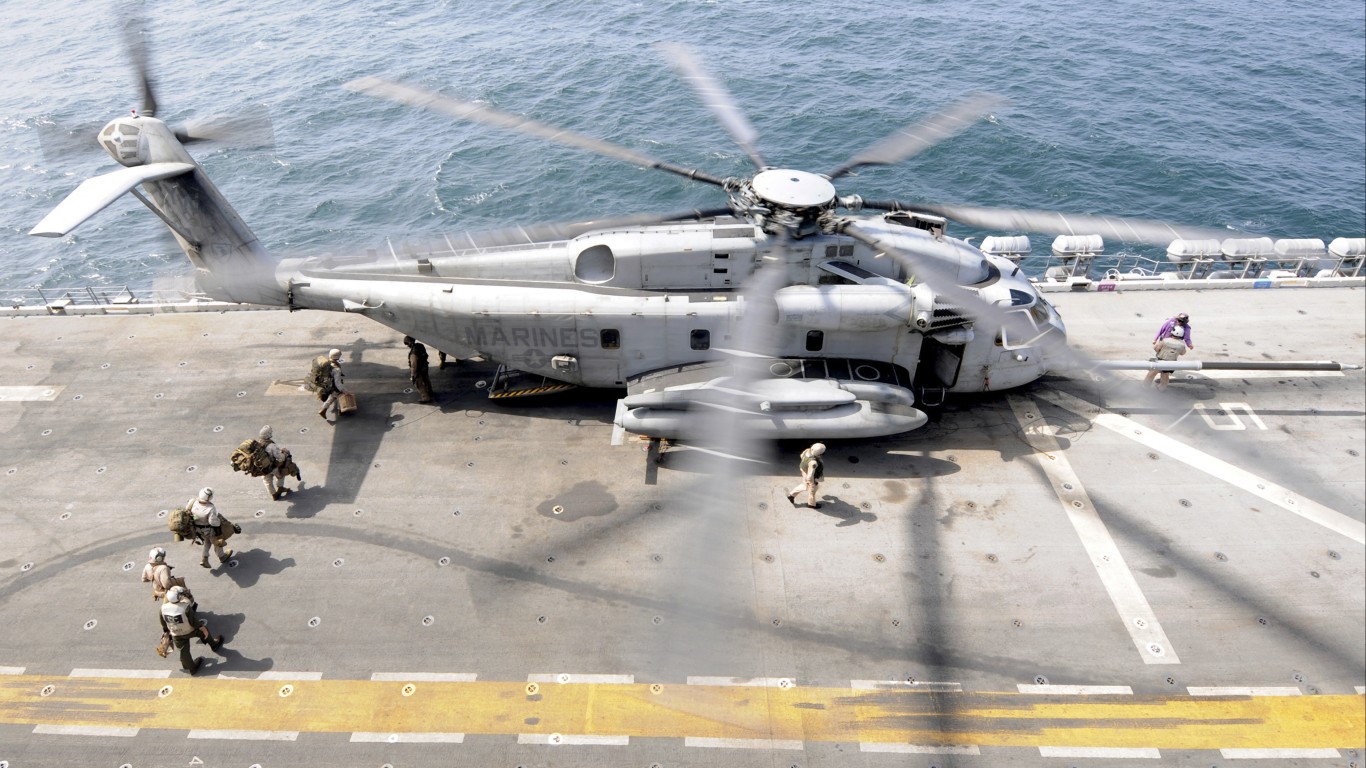
- Type: Multi-role transport helicopter
- Year introduced: 1981
- Active aircraft: 26
- Top speed: 196 mph
- Armament: 7.62mm M134 miniguns, 12.7mm Browning M2 heavy machine guns
The MH-53E Pave Low, introduced in 1981, is a multi-role transport helicopter with 26 active aircraft in service. It can hit a top speed of 196 mph and is heavily armed with 7.62mm M134 miniguns and 12.7mm Browning M2 heavy machine guns. This helicopter is used for long-range insertion and extraction missions.
MV-22 Osprey

- Type: Tilt-rotor VTOL aircraft
- Year introduced: 2007
- Active aircraft: 27
- Top speed: 316 mph
- Armament: 7.62mm machine guns, 12.7mm machine guns
Known for its unique ability to takeoff and land vertically like a helicopter and then adjust its rotors to operate like a turboprop plane, the MV-22 Osprey is one of the more unique aircraft in the U.S. Navy. It is manufactured by Bell Boeing and plays key roles in U.S. special operations missions like infiltration, extraction, and resupply. The U.S. Marine Corps uses this aircraft extensively for troop deployment and extraction, or even just for logistical purposes. The Osprey also can refuel mid-flight which significantly extends its range for longer missions.
P-3 Orion

- Type: Multi-mission reconnaissance, anti-submarine aircraft
- Year introduced: 1962
- Active aircraft: 17
- Top speed: 466 mph
- Armament: Torpedoes, depth charges, Harpoon missiles, SLAM-ER missiles, Maverick missiles, naval mines, unguided rockets
The P-3 Orion is based on the Lockheed L-188 Electra commercial airliner but has been heavily modified for military use, featuring advanced sensors and signal processing technologies. The Orion was introduced in 1962 and there are 17 aircraft in active service. These aircraft are slowly being phased out for the newer P-8A Poseidon.
It’s worth noting that the Orion has been used by multiple navies and air forces around the world. It has even found roles outside of the military in atmospheric research and oil spill monitoring.
P-8A Poseidon
- Type: Multi-mission reconnaissance, anti-submarine aircraft
- Year introduced: 2013
- Active aircraft: 118
- Top speed: 490 mph
- Armament: Torpedoes, naval mines, air-to-surface missiles, anti-ship missiles, stand-off cruise missiles
The P-8A Poseidon, introduced in 2013, is a newer and more sophisticated multi-mission reconnaissance and anti-submarine aircraft. There are currently 118 of these aircraft in service. With a top speed of 490 mph, the Poseidon is armed with torpedoes, naval mines, and a variety of missiles including air-to-surface, anti-ship, and stand-off cruise missiles. This advanced aircraft is slowly phasing out the P-3 Orion series.
S-70 Black Hawk
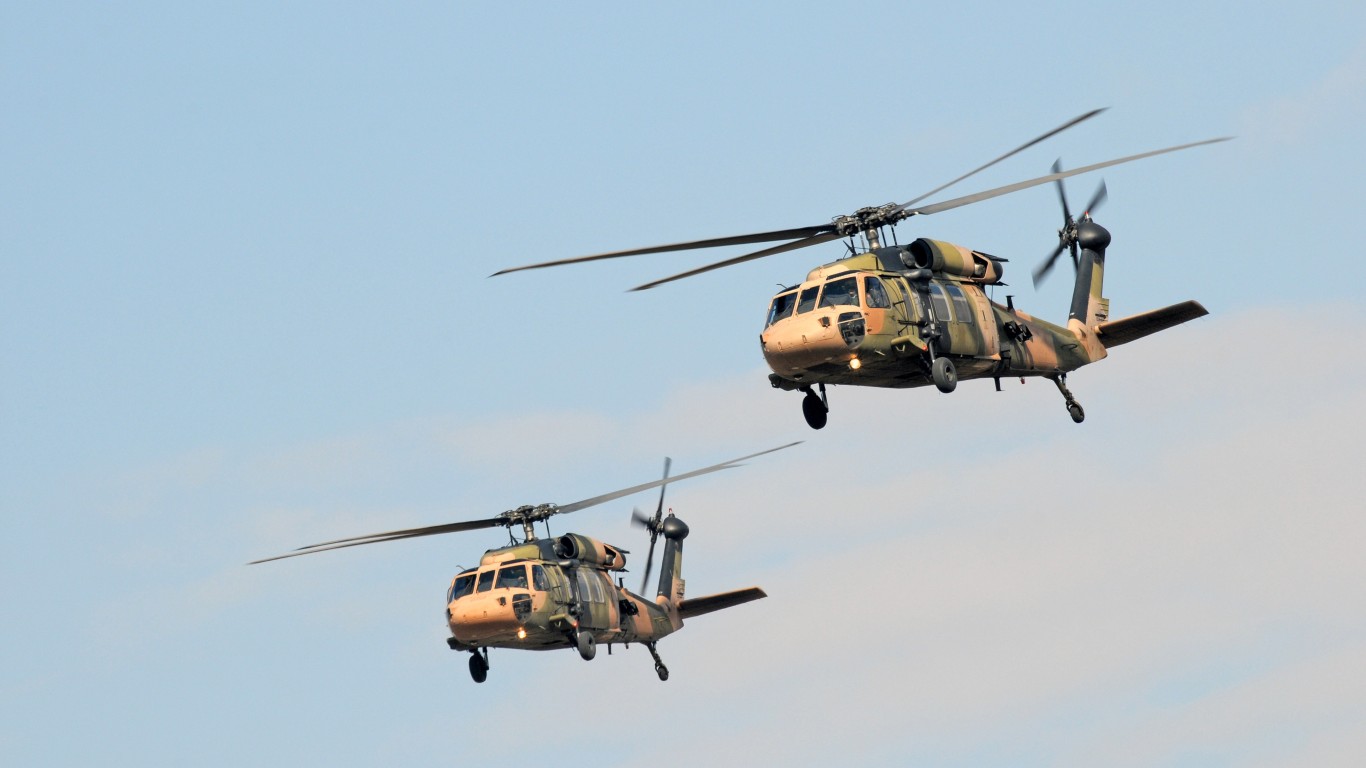
- Type: Medium-lift multi-mission helicopter
- Year introduced: 1979
- Active aircraft: 454
- Top speed: 183 mph
- Armament: 7.62mm machine guns, Hellfire missiles, 12.7mm gatling guns, M134 gatling guns, rocket pods, 30mm chain gun
Black Hawk helicopters have played important roles in conflicts around the globe. One infamous instance was the conflict in Somalia in 1993, particularly the Battle of Mogadishu. The Black Hawk played a significant role in urban combat and casualty evacuation under intense fire. This story would go on to make it as a blockbuster movie famously titled “Black Hawk Down.”
It is by far one of the most iconic helicopters ever built. It is the workhorse of the U.S. military with over a few thousand units currently in service across all branches.
The Black Hawk features twin turboshaft engines, a single four-bladed main rotor, and a four-bladed tail rotor, which allow for top speeds over 180 mph. Typically, this helicopter carries a crew of two pilots and two crew chiefs and can transport up to 11 fully equipped soldiers. In total, the Black Hawk can carry a payload of roughly 9,000 pounds.
Get Ready To Retire (Sponsored)
Start by taking a quick retirement quiz from SmartAsset that will match you with up to 3 financial advisors that serve your area and beyond in 5 minutes, or less.
Each advisor has been vetted by SmartAsset and is held to a fiduciary standard to act in your best interests.
Here’s how it works:
1. Answer SmartAsset advisor match quiz
2. Review your pre-screened matches at your leisure. Check out the advisors’ profiles.
3. Speak with advisors at no cost to you. Have an introductory call on the phone or introduction in person and choose whom to work with in the future
Thank you for reading! Have some feedback for us?
Contact the 24/7 Wall St. editorial team.


